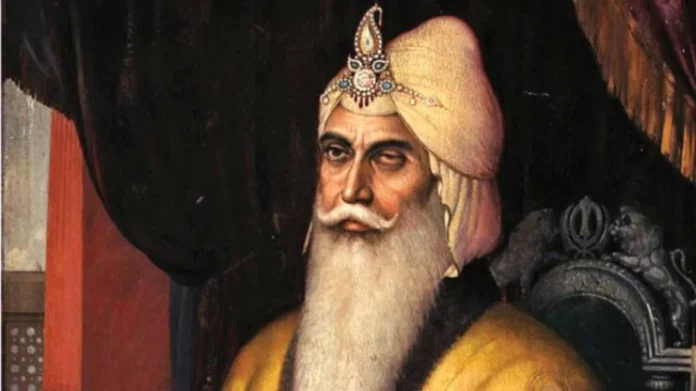Zorawar Singh Kahluria (1784-1841) known as the Napoleon of India for his conquests in the Himalayan areas, including Ladakh, Tibet, Baltistan and Skardu, was a military general of Dogra Rajput ruler Gulab Singh of Jammu. As the governor (wazir-e-wazarat) of Kishtwar, Zorawar extended the territories of the kingdom.
General Zorawar Singh also attempted the conquest of Western Tibet (Ngari Khorsum) but was killed in the battle of To-yo during the Dogra-Tibetan war.
He was born in September 1784 in a Kahluria Rajput family in the princely state of Kahlur (Bilaspur) state, in present-day Himachal Pradesh. His family migrated to the Jammu region where, on coming of age, Zorawar took up service under Raja Jaswant Singh of Marmathi (modern Doda district). Zorawar Singh was employed by the ambitious Raja Gulab Singh and was placed under the commandant of the Reasi fort (Bhimgarh fort). While delivering a routine message to Gulab Singh, Zorawar told him of the financial waste occurring in the fort administration, which impressed the Raja who appointed him the commandant of Reasi.
Commissariat officer
Later, seeing the honesty and sincerity of the General, the Raja appointed him commissariat officer of all forts north of Jammu. He was later made governor of Kishtwar and was given the title of Wazir (minister).
Even though it was a newly-conquered region, Zorawar had no trouble in maintaining the peace; many of the local Rajputs were recruited into his army.
To the east of Kishtwar and Kashmir are the snow-clad mountains of the upper Himalayas — the rivers of Zanskar Gorge, Suru River and Drass originate from the melting snow of these mountains, and flow across the plateau of Ladakh into the Indus River. Several petty principalities in this region paid tributes to the Gyalpo of Ladakh (King). In 1834, one of these, the Raja of Timbus, sought Zorawar’s help against the Gyalpo. Meanwhile, the Rajput general had been wanting to expand the territory of Raja Gulab Singh — also at that time, according to the Gulabnama, Kishtwar went through a drought that caused a loss of revenue and forced Zorawar to extract money through war.
Mountain fighting
The Rajputs of Jammu and Himachal traditionally excelled in mountain fighting; therefore, Zorawar had no trouble in crossing the mountain ranges and entering Ladakh through the source of the Suru River where his 5000 men defeated an army of local Botis.
After moving to Kargil, Zorawar received the submission of the Ladakhis — however, Tsepal Namgyal, the Gyalpo (ruler), sent his general Banko Kahlon by a roundabout route to cut off Zorawar’s communications. The astute general doubled back to Kartse, where he sheltered his troops through the winter. In the spring of 1835, he defeated the large Ladakhi army of Banko Kahlon and marched his victorious troops towards Leh. The Gyalpo agreed to pay Rs 50,000 as war-indemnity and Rs 20,000 as an annual tribute.
Alarmed at the gains of the Dogras, Kashmir governor Mehan Singh incited the Ladakhi chieftains to revolt but Zorawar quickly marched back to the Himalayan valleys and subdued the rebels, consequently forcing the Raja of Zanskar to also pay a separate tribute to Jammu. But in 1836, Mehan Singh, who was in correspondence with the Lahore durbar, instigated the Gyalpo this time to revolt — Zorawar force-marched his army in ten days to surprise the Ladakhis and forced them to submit. He built a fort outside Leh and placed there a garrison of 300 men under Dalel Singh — the Gyalpo was deposed to an estate and a Ladakhi general, Ngorub Stanzin, was made the king. But the latter did not prove to be loyal hence the Gyalpo was restored to his throne in 1838.

Baltistan invasion
Muhammad Shah, the son of Skardu ruler Raja Ahmad Shah, fled to Leh and sought the help of the Gyalpo and Zorawar against his father. But some of the Ladakhi nobles allowed Ahmad Shah to imprison his son and sought his aid in a general rebellion against the Dogras. After defeating the Ladakhi rebels, Zorawar invaded Baltistan in the winter of 1839/40 adding a large contingent of Ladakhis to his army.
On their arrival, the Botis of Skardu were defeated and forced to flee. They were chased to the fort of Skardu, which was invested by Zorawar for a few days. Zorawar built a fort on the banks of the Indus where he placed a contingent of his soldiers.
One column under the Ladakhi prince, Nono Sungnam, followed the course of the Indus River to its source. Another column of 300 men, under Ghulam Khan, marched along the mountains leading up to the Kailas Range and thus south of the Indus. Zorawar himself led 3000 men along the plateau region where the vast and picturesque Pangong Lake is located. Sweeping all resistance before them, the three columns passed the Lake Manasarovar and converged at Gartok, defeating the small Tibetan force stationed there. The enemy commander fled to Taklakot but Zorawar stormed that fort on September 6, 1841. Envoys from Tibet now came to him as did agents of the Maharaja of Nepal, whose kingdom was only 15 miles from Taklakot.
Pilgrimage to Mansarovar
Zorawar and his men went on pilgrimage to Mansarovar and Mount Kailash. He had extended his communication and supply line over 450 miles of the inhospitable terrain by building small forts and pickets along the way. The fort Chi-T’ang was built near Taklakot, where Mehta Basti Ram was put in command of 500 men, with nine cannons. With the onset of winter, all the passes were blocked and roads snowed in. The supplies for the Dogra army over such a long distance failed despite Zorawar’s meticulous preparations.
As the intense cold, coupled with the rain, snow and lightning continued for weeks upon weeks, many of the soldiers lost their fingers and toes to frostbite. Others starved to death, while some burnt the wooden stock of their muskets to warm themselves. The Tibetans and their Chinese allies regrouped and advanced to fight back, bypassing the Dogra fort of Chi-T’ang. Zorawar and his men met them at the Battle of To-yo on December 12, 1841— in the early exchange of fire the Rajput general was wounded in his right shoulder but he grabbed a sword in his left hand. The Tibetan horsemen then charged the Dogra position and one of them thrust his lance in Zorawar Singh’s chest.
– The writer is a senior journalist and media consultant. The views expressed are of the writer and do not necessarily reflect the views of Raksha Anirveda
– The writer is a senior journalist and media consultant. The views expressed are of the writer and do not necessarily reflect the views of Raksha Anirveda.






